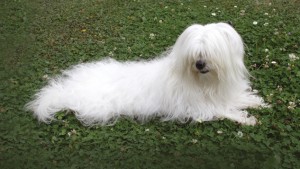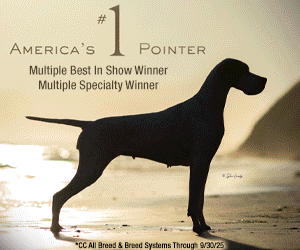The new Kids On the Block – What to Look for in the Coton De Tulear
Click here to read the complete article
By Melissa Engelking
This article’s main focus is how to evaluate the Coton de Tulear, aka the Coton, as a whole package. As with all breeds, there are some features that hold precedence. These priorities should be used when judging the Coton. One key fact to keep in mind while reading this article, as well as when judging these lovely dogs, is that they should be a balanced breed.
While back in the day the Coton may have been roaming the Malagasy terrain, today it is a companion breed. It was developed into a companion breed by those of its native land. Therefore, size and weight are of importance. The standard states that for bitches the ideal height is between 9 and 10 inches. Dogs should be between 10 and 11 inches. There is a tolerance for a half-inch below the ideal height and an inch above the ideal height, anything outside this height range is a disqualification. This is important not only because it is a disqualification, but also when you look at the first sentence of the standard… “The Coton de Tulear, also known as the “Royal Dog of Madagascar”, is a hardy, sturdy small white companion dog.” If a Coton is too small it is not “hardy” nor “sturdy,” and will often lose its breed type. However, if it is too big, it will no longer be the “small” “companion dog” it is meant to be. One cannot stress enough that this dog is a companion breed, and not meant to be too large.
Often height and weight correspond to one another. Even though weight is not a disqualification in the Coton, it is an important feature. Those who do not weigh enough will not be “sturdy” enough either. Those who weigh too much will not be the ideal companion either, as they will be too heavy. The ideal weight for a bitch is between 8 and 13 pounds, while a dog should be between 9 and 15 pounds. The standard also indicates that if two specimens are equal in all other ways, the preference is to be given to the one within the ideal weight limit.
Another important feature of the Coton is the head. When looking at the Coton from above, the head should be triangular. The ears are also triangular in shape, and are set high, but connect at the eye line. The eyes are extremely important. They should be fairly round, and either black or brown in color. While halos around the eyes look beautiful, they are not required. What is required is black pigment around the eyes, and nothing but black pigment. The pigment around the mouth should also be completely black as well. For clarification, while full pigmentation is preferred, it is only complete lack of pigment that is a disqualification. When looking at the head, the back skull is rather large and round, and in balance with its “capacious” muzzle.
When looking at the silhouette of the Coton, the body should be rather rectangular. However, it should never appear too long or too short. The neck is somewhat arched, and it goes smoothly into its topline, with the withers somewhat distinct. When looking at the topline one should be able to draw a straight line from the withers to the hip, and see a slight rise over the loin. The rise should start over the loin. The rise and the conformation of the loin are important. The loin cannot be too long, as it will obstruct the rise, which in turn will obstruct the topline and the general outline of the dog. When reading the standard and applying it to this breed, the word “moderate” should be of great importance. This breed is moderately angulated in the front and rear, creating a very balanced dog. When on the move the Coton should only have moderate reach and drive, yet it should do so with ease.
One feature that the word moderate should not apply particularly to is the coat. They are named partly because of their coat. Coton means cotton. At certain times, as we all know, dogs go through coat changes and blow their coat. Or you enter a bitch, and their hormones decide they have a different fate for the wonderful coat your bitch has. But, regardless, the all-white dog is preferred, and the coat texture should feel cottony. There may be some color on the tips of the ears, and less than 5 percent on the body. This only applies to dogs older than 12 months. But, black is not permitted at any age. Having black anywhere in the coat is a disqualification. These dogs should never be artificially parted, but will at times have a natural part because of their coat length. This is mostly seen in mature individuals.
When looking at the front and rear assembly of the Coton, one should be reminded that this is an ongoing project that we hope to correct. The Coton should have an upper arm that is approximately equal to the shoulder. The elbows should be close to the body. The legs should not bow at any part of the leg. This is seen often as the norm though. When looking at the rear, it should be muscled. The rear pastern should also be perpendicular. Once again, this is a feature we as breeders are working to correct, and the judge should award the dog that is the best total package.
These little “sturdy” and “boisterous” but never “demanding” dogs are a joy to live with, and handle. I am sure that you will find them to be a joy to judge as well. I would like to thank all of the breed experts who have helped me better understand the Coton, and let me write this article to further pass on this knowledge.
For further information please contact:
Melissa Engelking • Sheltiepaw@yahoo.com
Parent Club Website: www.usactc.org
Short URL: http://caninechronicle.com/?p=66715
Comments are closed












